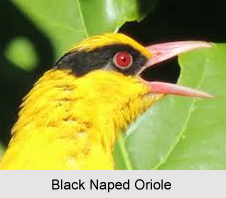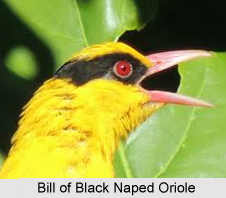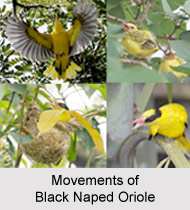 Black-Naped Oriole is an Indian bird that bears a scientific name "Oriolus chinensis" found in many parts of Asian countries and Indian States.
Black-Naped Oriole is an Indian bird that bears a scientific name "Oriolus chinensis" found in many parts of Asian countries and Indian States.
Black-Naped Oriole is a bird of the Oriole family and is found in many parts of Asia. There are several distinctive populations within wide distribution range of the species and in the past the slender-billed oriole "Oriolus tenuirostris" was included as a subspecies.
Structure of Black-Naped Oriole
Black-Naped Oriole has a short and narrow eye-stripe, the black-naped oriole has the stripe broadening and joining at the back of the neck. Males and females are very similar although the wing lining of the female is more greenish. The bill is pink and is stouter than in the golden oriole.
Size of Black-Naped Oriole
Black-Naped Oriole is medium-sized and overall golden with a strong pinkish bill and a broad black mask and nape. The adult male has the central tail feathers tipped yellow and the lateral ones are more broadly yellow. The female has the mantle coloured more greenish or olive. The juvenile has a streaked underside.
Nestling of Black-Naped Oriole
The nestling of Black-Naped Oriole has dull greenish streaks with brown shades. The head and nape are more yellowish and the under tail coverts are yellow. Several variations exist in the populations that have been separated as subspecies.
 Migration of Black-Naped Oriole
Migration of Black-Naped Oriole
Black-Naped Oriole has the subspecies diffuses that breeds in China and is widespread across India during winter, mainly in the north-eastern parts and in the peninsular region. The population in the Andaman and Nicobar Islands are resident. The subspecies in the Andamans, O. C. Andamanensis has all black wings while O. C. Macrourus of the Nicobars has a very broad nape band so that only the top of the head is yellow. The wings are all black with a yellow primary covert patch.
Sound of Black-Naped Oriole
The calls of Black-Naped Oriole in the Andaman and the Nicobar Islands subspecies are said to be quite different, the latter having a more modulated call note. The evolutionary history of this group of orioles is complex and there may be more cryptic species within the group.
Population of Black-Naped Oriole
In the Southeast Asian populations of Black-Naped Oriole some geographic trends include a reduction of yellow on the forehead and a decreased brightness in the yellow plumage from north to south. Females from southern populations are more greenish on the back and tail and there are no yellow spots on the tips of the secondaries as in northern populations.
Concentration of Black-Naped Oriole
Black-Naped Oriole is found in forests, gardens and plantations. It feeds on berries and insects in the canopy. Subspecies diffusus breeds in eastern Siberia, Ussuriland, northeastern China, Korea and northern Vietnam and winters in Thailand, Burma and parts of India. T. C. Jerdon described a bird from the Malabar region that he identified as Oriolus Indicus and this is now considered to be Oriolus chinensis diffusus. Oriolus Chinensis Invisus is found in Southern Annam. The nominate population is from the Philippines. Several island populations have been described including suluensis (Sulu Island), melanisticus (Talaut Islands), formosus (Sangihe), frontalis (Sula Islands), sangirensis (Sangi Archipelago), saani (Moluccas), mundus (Simalur Island), sipora (Sipora Island), richmondi (Siberut and Pagi), insularis (Kangean), broderipii (Lombok, Sumba, Sumbawa, Flores, and Alor Islands), lampochryseus (Masalembo and Keramian Islands), oscillans (Tukang Besi Islands), boneratensis (Islands of Bonerate, Djampea and Kalao), maculatus (Singapore Island, Sumatra, Billiton, Banka, Nias, Java. Bali and Borneo), yamamurae (central and southern Philippines and sometimes treated as identical to the nominate population), celebensis (northern Celebes) and macassariensis (southern Celebes). The subspecies are very closely related and the group forms a clade in which the Eurasian oriole and Indian golden oriole are also nested.
 Feeding of Black-Naped Oriole
Feeding of Black-Naped Oriole
Black-Naped Orioles have been recorded to feed on a range of berries including Trema orientalis, Ficus and others apart from insects. It has been suggested that they may have aided in the dispersal of Ficus species into the island of Krakatoa where they were also among the early pioneer species. In India it has been noted to take nectar from large flowers such as those of Salmalia and Erythrina. They can sometimes be nest predators on smaller birds.
Breeding Season of Black-Naped Oriole
The breeding season of Black-Naped Oriole is from April to June (January-March in the Andaman and Nicobar Islands) and the nest is a deep cup in a fork of a tree. The eggs, two to three, are salmon pink with reddish spots and darker blotches.
Nests of Black-Naped Oriole
The nests of Black-Naped Oriole are often built in the vicinity of the nest of a black drongo. Two or three nests may be built by the female and one is finally chosen for laying eggs. Males may sometimes sit beside the unused nests. Incubation is by the female alone and the eggs hatch after 14 to 16 days and the chicks fledge after another two weeks. Females stay closer to the nest, taking part in nest sanitation by removal of fecal sacs, driving away predators and feeding the young. The males take a more active role in feeding and guarding. Eurasian tree sparrows and black bulbuls may sometimes use abandoned nests. Nest predators include crows, treepies and hawks. In many parts of Southeast Asia, they are trapped and sold in the bird trade.



















